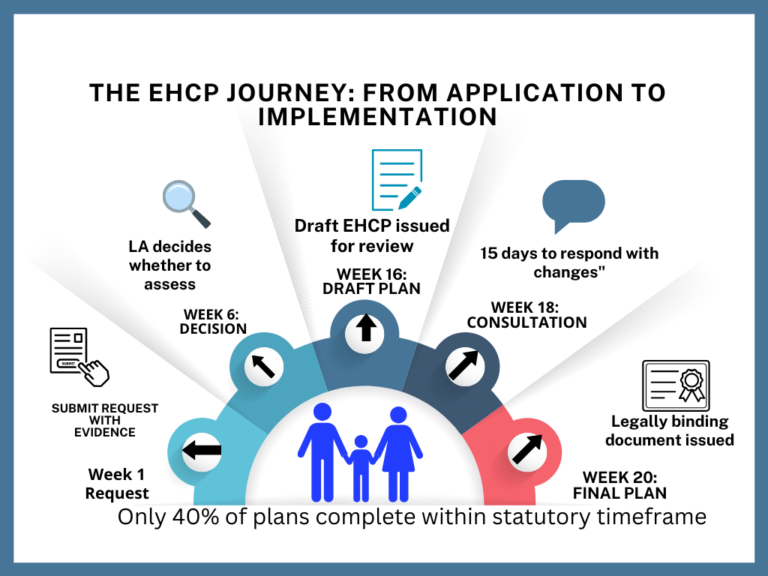How to Apply for an EHCP as a Parent: Step-by-Step Guide for Success
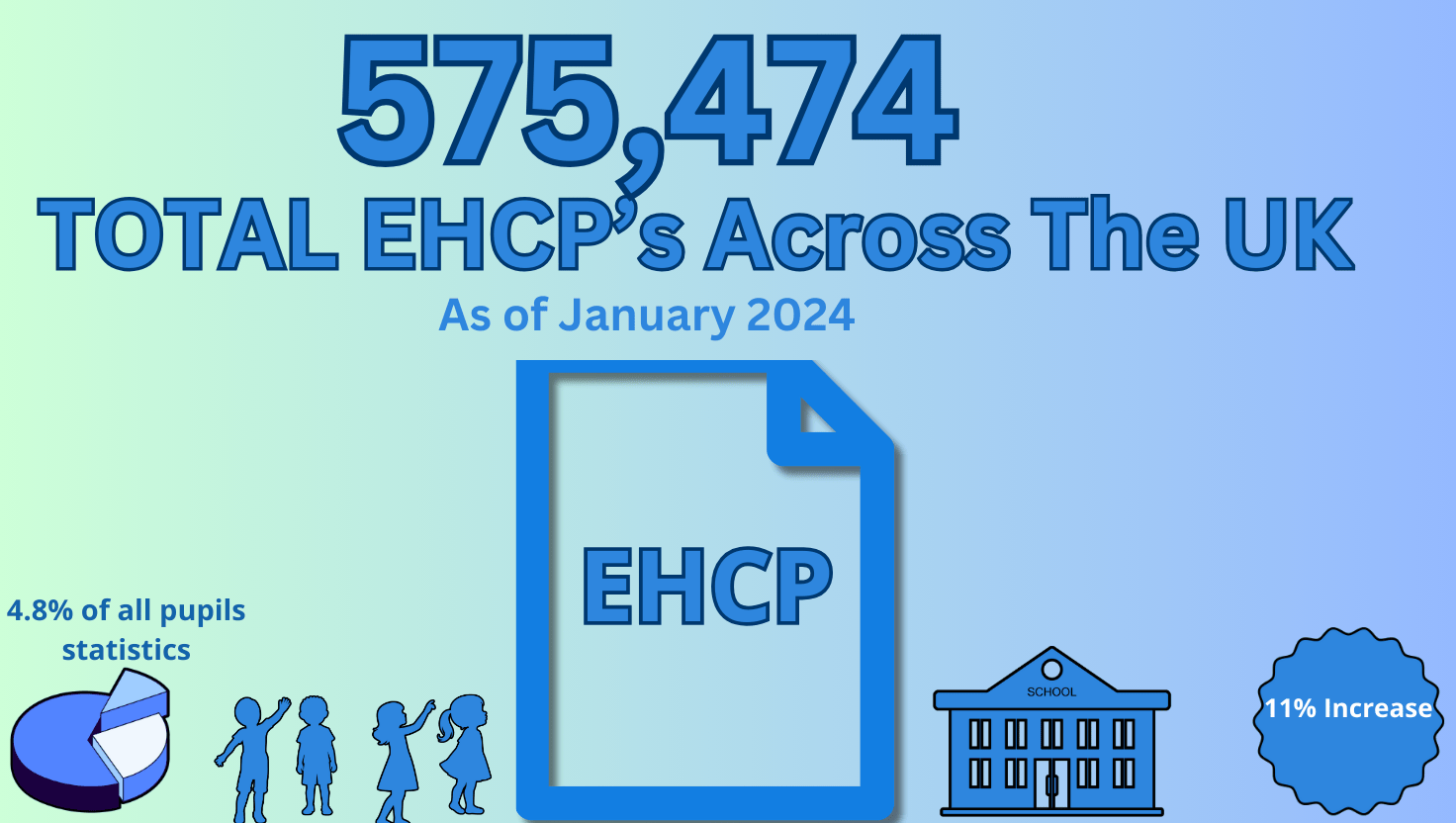
Key Takeaways:
1. EHCP Basics: When learning how to apply for an EHCP as a parent, understand that an Education, Health and Care Plan is a legally binding document
created through the application process that outlines comprehensive support for children with special educational needs,
backed by the Children and Families Act 2014.
2. Who Can Apply: Parents, schools or professionals can request an EHCP assessment.
Parents must submit a written request to their Local Authority’s SEN department.
3. Legal Timeline: The entire process takes 20 weeks:
- Weeks 0-6: Local authority (LA) decides whether to assess
- Weeks 6-16: Assessments conducted
- Weeks 16-18: LA decides whether to issue a plan
- Weeks 18-20: Plan finalization
4. Evidence Needed: Include diagnoses, professional reports, details of difficulties and why current support is insufficient. Be specific and comprehensive.
5. Eligibility: Children with significant needs that can’t be met with regular school resources qualify – this includes autism, dyslexia, ADHD and speech difficulties.
No formal diagnosis is necessarily required.
6. Draft Review: You have 15 days to review the draft EHCP.
Ensure needs are accurately described with specific, quantified provision (e.g. “Weekly 30-minute speech therapy with a qualified therapist”).
7. Legal Structure: Every need in Section B must have matching support in Section F. Health needs (Section C) need health provision (Section G).
8. Appeals Process: If rejected, you can appeal to the SEND Tribunal. Most appeals require mediation first (except for “refusal to assess”). SENDIASS offers free support.
9. Persistence Matters:Many successful EHCPs come after initial refusals. Document everything, follow up regularly and remain professional in all communications.
10. Support Available: (SENDIASS) Special Educational Needs and Disability Information Advice and Support Service provides free, impartial advice throughout the process, including help with appeals and understanding your legal rights.
A Parent’s Guide to Applying for an EHCP in 2025
The EHCP application process can seem daunting at first but it’s a crucial step in securing the right support for your child.
As of January 2024, there were 575,474 pupils with an Education, Health and Care (EHC) plan, an increase of 9.4% on 2023, according to the Department for Education (DfE) [SEN statistics: January 2024 – GOV.UK].
This significant increase underscores the growing need for individualized support for children and young people with special educational needs and disabilities,
highlighting the importance of understanding the EHCP application process for parents.
Whether your child is having a tough time at school with special educational needs or a teacher has suggested you look into an EHCP.
This guide will make the whole process much clearer.
The EHCP application process doesn’t need to be overwhelming – the SEND Code of Practice actually gives you clear rights as a parent.
Parents like you deserve simple, easy-to-follow information about getting the right help for your child.
I’m going to walk you through exactly how to request an Education, Health and Care Plan for your child.
What happens during the statutory assessment process and how to deal with any roadblocks you might face along the way.
From understanding the Children and Families Act 2014 to knowing your parental rights in the EHCP process, this guide covers everything you need to navigate the system successfully and secure the specialized support your child deserves.
What is an EHCP and Why Might My Child Need One?
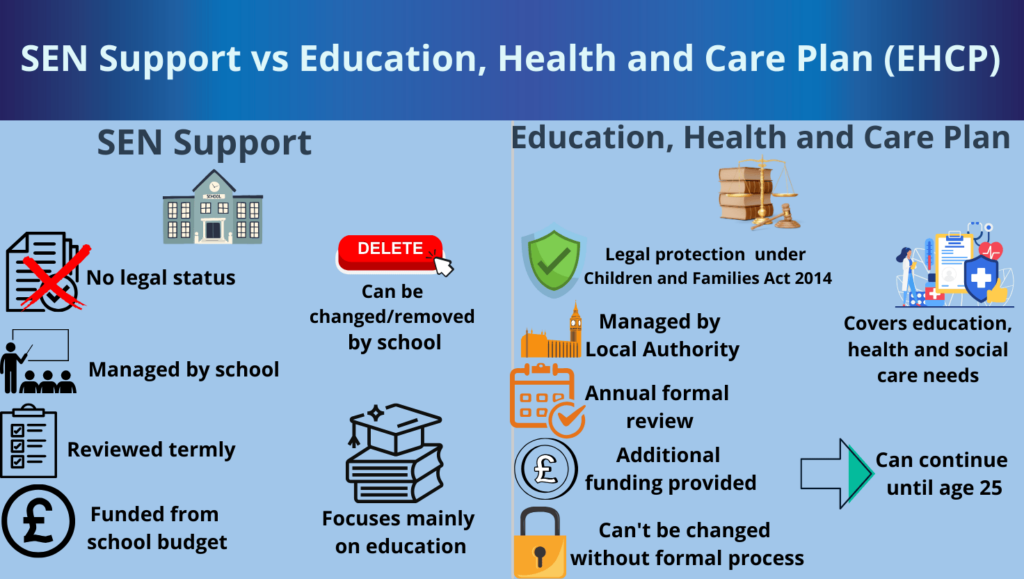
When I first heard about EHCPs, I was lost. An Education, Health and Care Plan (EHCP) is a legal document outlining what extra help a child needs at school, backed by the Children and Families Act 2014.
The difference between SEN Support and an EHCP?
SEN Support comes from school resources, coordinated by the SEN coordinator.
An EHCP provides legal protection – schools MUST provide the specified and quantified provision detailed in the plan.
Your child might need an EHCP if they meet the eligibility criteria – having significant needs that regular resources can’t meet.
This includes children with autism, dyslexia, ADHD or speech difficulties.
For parents concerned about autism specifically, getting a proper assessment is often the first crucial step before applying for an EHCP.
Many parents aren’t aware they have options when it comes to autism assessments in the UK. [Fast-track autism assessments: your right to choose] and how this can impact your EHCP application
If they’re not progressing despite current help, this includes knowing the EHCP application process
Your child gets legally protected individualised assistance through school and potentially into post-16 education.
Benefits?
You get input on school choice, including special school placements if needed.
Common myths?
Only visibly disabled children qualify. (False – you can get an EHCP without a formal diagnosis in many cases).
IPSEA provides information about when a diagnosis is and isn’t needed (https://www.ipsea.org.uk/what-you-need-to-know/ehc-needs-assessments/evidence-of-need).
The application process is too complicated. (challenging but manageable).
With support from local SEND services and resources from organisations such as IPSEA, you can navigate the process effectively [https://www.ipsea.org.uk/getting-help].
How Do Parents Start the EHCP Application Process?
The EHCP application process begins with understanding who can initiate it.
Parents have the right to request an assessment!
While parents or carers, the school and professionals working with your child (doctors, therapists) can all request an EHCP assessment, don’t wait for someone else to act.
As a parent, you know your child best!
Making a request to your Local Authority (LA) is pretty straightforward.
You’ll need to write a letter or email to the Special Educational Needs department of your Local Authority.
Submitting your request in writing creates a clear record of your application date and details for future reference and legal protection
Gathering Initial Evidence:
Before formally requesting an EHCP assessment, gather any existing evidence supporting your child’s needs.
This might include:
- School reports detailing academic progress and interventions.
- Reports from educational psychologists, therapists or medical professionals.
- Letters from teachers outlining specific challenges.
- Records of previous support or interventions.
- Your own notes and observations.
Having this readily available will strengthen your request.

How Do I Begin the EHCP Application Process
Here’s a simple template you can use for your EHCP assessment request:
[Your Address]
[Your Email/Phone]
[Date]
Special Educational Needs Department
[Local Authority Name and Address]
Re: Request for EHC Needs Assessment for [Child’s Full Name, DOB]
Dear Sir/Madam,
I am writing to request an Education, Health and Care needs assessment for my child, [Child’s Name], under section 36(1) of the Children and Families Act 2014.
[Child’s Name] currently attends
[School Name] and has the following special educational needs:
[briefly list main difficulties].
Despite the support provided at school through SEN Support,
[Child’s Name] continues to experience significant difficulties with
[mention key areas of struggle].
I believe [Child’s Name] may need more support than the school can provide from their own resources because [give 2-3 specific examples of ongoing difficulties].
I am enclosing [list any reports or evidence you’re including].I look forward to hearing from you within the statutory six-week timeframe regarding your decision whether to assess.
Yours faithfully,
[Your Name]
When filling out your application, make sure to include as much information as possible about your child’s needs.
This means mentioning any diagnoses, reports from professionals, details about their difficulties at school, and how these affect their daily life.
Be specific about what support they’re already getting and why it isn’t enough.
To navigate the EHCP application you need to clearly describe your child’s challenges
Timing is everything when applying for an EHCP.
The best time to apply is when you have evidence that your child isn’t making progress despite the school’s efforts to support them.
Don’t wait until your child is in crisis – if they’ve been on SEN Support for at least two terms with little improvement, that’s often a good time to consider an EHCP request.
Also, think about transition periods – applying before your child moves to a new school gives time for the plan to be in place when they start.
Remember, successfully securing educational support for your child means being persistent.
The Local Authority has 6 weeks to decide whether to assess your child and the whole process should take no more than 20 weeks from start to finish.
But don’t be discouraged if you face setbacks – many successful EHCPs come after initial refusals.
Your determination will make all the difference to your child’s future!
What is the Timeline for an EHCP Application?

The timeline requires familiarity with the 20 week legal process from application to plan
Weeks 0-6: The Local Authority (LA) decides whether to assess your child.
They must respond within 6 weeks of your request. This is your first major hurdle when applying for an EHCP as a parent.
Weeks 6-16: If approved, assessments happen.
The Local Authority gathers evidence from educational psychologists, therapists, medical professionals, and the school.
You’ll also provide your views – be thorough and specific about your child’s needs!
Weeks 16-18: The Local Authority decides whether to issue an EHCP based on the evidence. If yes, you’ll receive a draft plan.
If no, you have the right to appeal.
Weeks 18-20: The plan gets finalized.
You can request changes to the draft and express school preferences.
The final plan must be issued by week 20.
Delays are common but not acceptable when applying for an EHCP as a parent. If deadlines slip, politely remind the Local Authority of their legal duties.
Keep records of all communications and dates.
A gentle reminder that they’re exceeding legal timeframes often helps.
Know your rights! The Local Authority must follow these timeframes.
If they’re significantly late, you can file a formal complaint, contact your local SENDIASS for support or consider a judicial review for extreme delays.
Stay focused on getting your child the support they need.
Track dates, follow up regularly and advocate firmly if things take too long.
How you handle this process can significantly impact how quickly your child receives appropriate support.
How Do Local Authorities Evaluate Parent EHCP Applications?
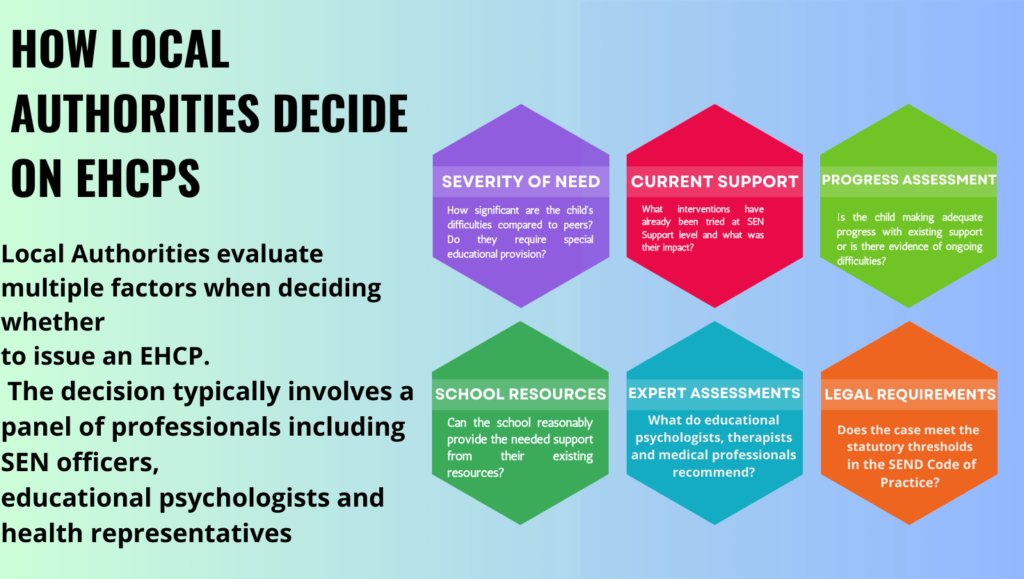
Next steps?
If approved, review the draft carefully using the checklist in the next section. If refused, immediately contact your local SENDIASS for free, impartial advice on next steps and remember that many plans get approved after initial refusals.
Don’t give up – gather additional evidence and consider pursuing mediation or an appeal.
It can also be useful to ask the Local Authority for detailed reasons why the EHCP was refused, so that these reasons can be addressed with further evidence.
If the Local Authority says no, they must explain why in writing.
You have two months to either try mediation or appeal to the SEND Tribunal.
Mediation is a meeting with someone neutral to talk things through with the Local Authority.
How Should Parents Review and Finalize Their Child’s EHCP?

To ensure your draft EHCP is comprehensive and legally sound, carefully review it, paying particular attention to these key elements and sections to guarantee all your child’s needs are met:
Checklist key elements:
Does the draft describe all your child’s difficulties? This is the foundation of the EHCP – if needs aren’t recognised, they can’t be met.
Is anything from the professional reports missing? Professional reports provide crucial evidence of your child’s needs; ensure all key recommendations are included.
Is every need in Section B matched with support in Section F? Section B outlines your child’s special educational needs.
Section F details the specific, quantified support required to meet those needs. These sections MUST align for the EHCP to be legally sound and effective.
Do Health needs (Section C) have health support (Section G)? Section C outlines health needs related to SEN, while Section G details the necessary health provision. Just like B and F, these must match.
Can the named school provide everything listed? Ensure the named school has the resources and expertise to deliver the provision outlined in the plan.
Does the plan cover all needs? Is it clear who does what, how often? Are goals measurable? A legally sound EHCP provides clarity on responsibilities, frequency of support, and how progress will be measured.
For a legally strong EHCP, every need in Section B must have matching support in Section F. Health needs (Section C) need health support (Section G). The school named must be able to provide everything listed.
Quick check:
- Does the plan cover all needs?
- Is it clear who does what, how often?
- Are goals measurable?
If you’re unsure, ask SENDIASS for help. Successfully securing appropriate educational support includes getting guidance during this important stage.
What Can Parents Do If Their EHCP Application Is Refused?
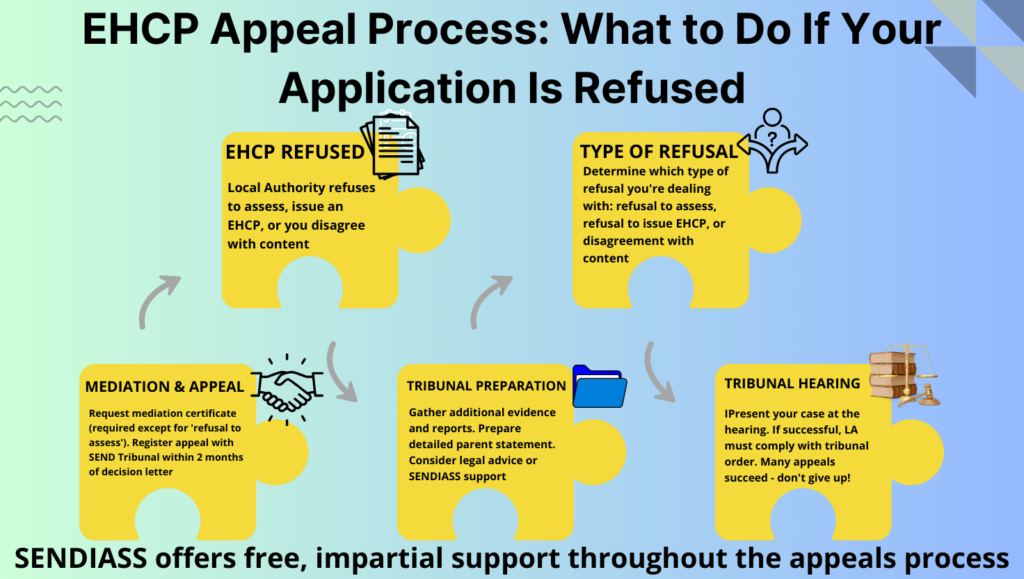
If you’ve applied for an EHCP as a parent but got rejected;
You can start the EHCP appeal process through the SEND Tribunal if the Local Authority refuses to assess, refuses to issue an EHCP or if you disagree with what’s in the final plan.
You must register your appeal with the SEND Tribunal within two months of the date on the decision letter from the Local Authority.
Most EHCP refusal appeals require trying mediation first. You’ll get a mediation certificate with the Local Authority’s decision letter.
This lets you meet with an independent person to discuss your concerns with the Local Authority.
For “refusal to assess” appeals only, you can skip straight to the Tribunal if you want.
SENDIASS support offers free, impartial help during appeals.
They provide independent advice for parents, can explain the process, review your case and even attend meetings with you.
Many parents say their support made all the difference when navigating children with disabilities education rights.
Gather stronger evidence for your appeal. Get updated reports from therapists, an educational psychologist assessment, detailed letters from teachers or private assessments if possible.
A strong parent statement for EHCP can make a huge difference.
Focus on showing why your child needs more support than regular schools typically provide.
Keep relationships positive during disputes. Stay factual about your child’s needs rather than getting angry.
Be professional and polite in all communications – the people you’re disagreeing with now may be implementing your child’s EHCP in schools later.
Throughout the EHCP application process, maintaining a persistent yet professional approach, grounded in a solid understanding of your rights, is more likely to achieve a positive outcome than resorting to confrontation.
Ready to take the next step in securing the right support for your child?
Contact your local SENDIASS for free, impartial advice and support throughout the EHCP process.
Remember: You are your child’s best advocate – with knowledge and persistence, you can make a difference!
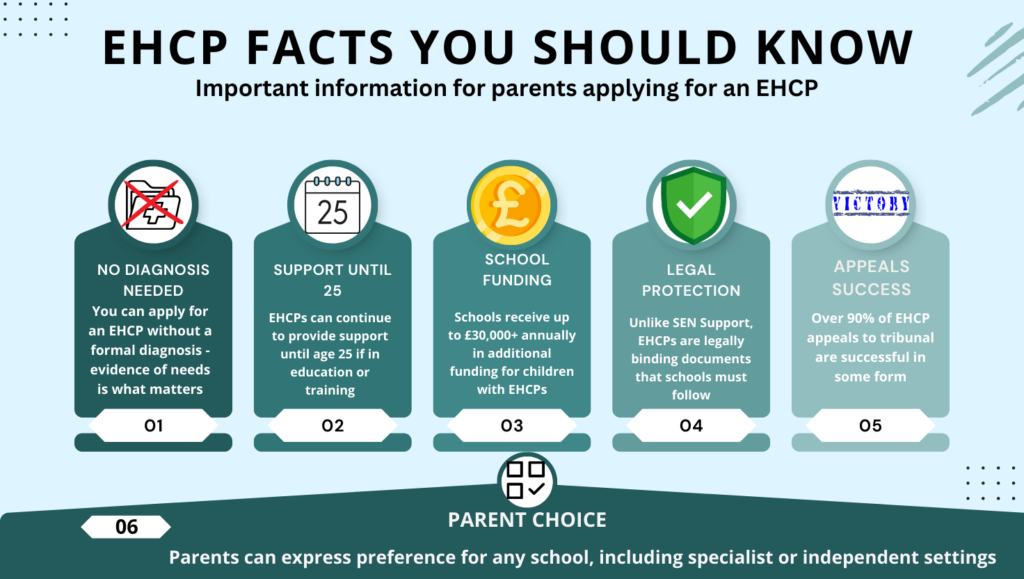
Frequently Asked Questions About Applying for an EHCP
Next Steps After Securing Your Child’s EHCP
Applying for an EHCP might seem overwhelming, but armed with the right information, you can successfully navigate the process.
Remember that as a parent, you know your child best and have every right to advocate for the support they need.
Don’t be discouraged by initial refusals or bureaucratic hurdles—persistence often pays off.
If you’re facing challenges, reach out to support organizations who can provide guidance specific to your situation.
By following the steps outlined in this guide, you’ll be well-equipped to secure the educational support your child deserves through an EHCP in 2025 and beyond.
Disclaimer: This information in this guide is intended for informational purposes only and does not constitute legal advice. The EHCP process and related laws and regulations are subject to change. It is essential to consult with a qualified legal professional or SENDIASS advisor for personalized guidance on your specific situation. The author and publisher are not responsible for any actions taken or not taken based on the information in this guide.
About the Authors: Dwayne and Charlene are committed to providing accessible and reliable information to families with special needs. Charlene’s extensive experience working with children of all abilities as a professional childminder combines with Dwayne’s personal journey as a father to their son with autism to provide families with a deep understanding of the issues families face. Together, they offer practical guidance and support.
